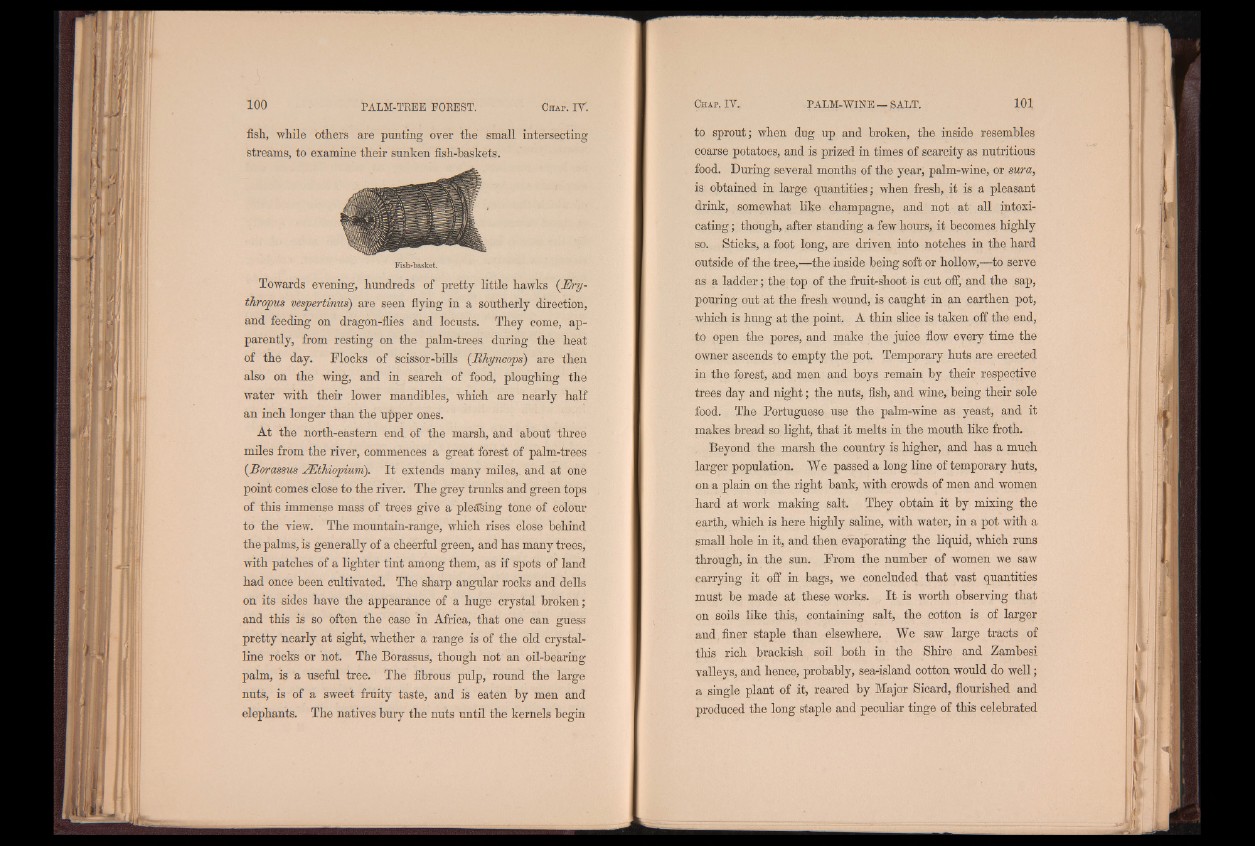
fish, while others are punting over the small intersecting
streams, to examine their sunken fish-haskets.
Fish-basket.
Towards evening, hundreds of pretty little hawks (Ery-
thropus vespertinus) are seen flying in a southerly direction,
and feeding on dragon-flies and locusts. They come, apparently,
from resting on the palm-trees during the heat
of the day. Flocks of seissor-bills (Rhyncops) are then
also on the wing, and in search of food, ploughing the
water with their lower mandibles, which are nearly half
an inch longer than the upper ones.
At the north-eastern end of the marsh, and about three
miles from the river, commences a great forest of palm-trees
(Borassus JEthiopium). I t extends many miles,, and at one
point comes close to the river. The grey trunks and green tops
of this immense mass of trees give a pleasing tone of colour
to the view. The mountain-range, which rises close behind
the palms, is generally of a cheerful green, and has many trees,
with patches of a lighter tint among them, as if spots of land
had once been cultivated. The sharp angular rocks and dells
on its sides have the appearance of a huge crystal broken;
and this is so often the case in Africa, that one can guess
pretty nearly at sight, whether a range is of the old crystalline
rocks or not. The Borassus, though not an oil-hearing
palm, is a useful tree. The fibrous pulp, round the large
nuts, is of a sweet fruity taste, and is eaten by men and
elephants. The natives bury the nuts until the kernels begin
to sprout; when dug up and broken, the inside resembles
coarse potatoes, and is prized in times of scarcity as nutritious
food. During several months of the year, palm-wine, or sura,
is obtained in large quantities; when fresh, it is a pleasant
drink, somewhat like champagne, and not at all intoxicating
; though, after standing a few hours, it becomes highly
so. Sticks, a foot long, are driven into notches in the hard
outside of the tree,—the inside being soft or hollow,—to serve
as a ladder; the top of the fruit-shoot is cut off, and the sap,
pouring out at the fresh wound, is caught in an earthen pot,
which is hung at the point. A thin slice is taken off the end,
to open the pores, and make the juice flow every time the
owner ascends to empty the pot. Temporary huts are erected
in the forest, and men and hoys remain by their respective
trees day and night; the nuts, fish, and wine, being their sole
food. The Portuguese use the palm-wine as yeast, and it
makes bread so light, that it melts in the mouth like froth.
Beyond the marsh the country is higher, and has a much
larger population. We passed a long line of temporary huts,
on a plain on the right hank, with crowds of men and women
hard at work making salt. They obtain it by mixing the
earth, which is here highly saline, with water, in a pot with a
small hole in it, and then evaporating the liquid, which runs
through, in the sun. From the number of women we saw
carrying it off in bags, we concluded that vast quantities
must be made at these works. I t is worth observing that
on soils like this, containing salt, the cotton is of larger
and finer staple than elsewhere. We saw large tracts of
this rich brackish soil both in the Shire and Zambesi
valleys, and hence, probably, sea-island cotton would do well;
a single plant of it, reared by Major Sicard, flourished and
produced the long staple and peculiar tinge of this celebrated